How to Recognize the Symptoms of a Dry Socket Early

Dealing with a recent tooth extraction? Watch out for dry socket-it’s sneaky but shows early signs you can catch!
Ignoring it can turn a simple healing process into serious discomfort. Knowing what to look for makes all the difference. From sharp pain at the extraction site to a noticeable bad taste or odor, your mouth gives clues.
Spotting these early can speed up relief and prevent complications. Let’s explore how to recognize dry socket symptoms fast, so your recovery stays smooth and painless.
Intense Pain
After a tooth extraction, pain is normal, but dry socket pain is different. It often starts a few days after the procedure and feels sharp, deep, and persistent.
Over-the-counter painkillers may not help much and can radiate to the ear or jaw. This kind of discomfort signals that the healing clot might be dislodged, leaving the bone exposed.
Recognizing this intense pain early is crucial to preventing further complications. Don’t ignore it-listening to your body and noticing when the pain is strong is the first step toward proper care.
Bad Breath
A common but often overlooked sign of dry socket is bad breath. It can develop even with regular brushing and mouth rinsing. The odor comes from food particles and bacteria that accumulate in the open socket.
You might also notice an unpleasant taste that lingers in your mouth. Unlike regular post-extraction smells, this bad breath can be strong and persistent.
Sometimes, it is the first clue your mouth gives that something isn’t healing correctly, so noticing it early can make a big difference.
Visible Bone
Normally, the clot protects the bone and promotes healing, but when it dislodges, the bone becomes exposed. This can look white or yellowish and may make the area feel rough.
Exposure increases sensitivity and pain, and it slows the healing process. Regularly checking the extraction site after your procedure is important.
Noticing visible bone immediately allows you to seek care quickly. Early attention prevents infection and makes treatment more effective. This also ensures your mouth heals more comfortably and without complications.
Difficulty Eating and Drinking
Dry socket can make eating and drinking surprisingly tricky. Simple actions like chewing or sipping may trigger sharp, intense pain. Even soft foods can feel uncomfortable, and hot or acidic drinks can make the discomfort worse.
This can leave you frustrated and affect your daily nutrition. Paying attention to these challenges is important, as your mouth is signaling that healing isn’t progressing as it should.
Fortunately, early detection can help prevent the situation from worsening. Noticing difficulty with meals allows you to seek treatment sooner.
Small, soft bites, cooler foods, and careful sipping can ease discomfort while your dentist addresses the problem. Acting quickly helps your recovery stay smooth and pain-free.
Recognizing and Acting on Symptoms
Catching the early signs of dry socket can significantly speed up your recovery. Don’t ignore unusual pain, bad breath, or difficulty eating. Acting quickly helps prevent complications and speeds up healing.
Stay attentive to your mouth and reach out to your dentist if something feels off. Take charge of your recovery today and ensure a smoother, more comfortable healing process.
Did you find this article helpful? Check out the rest of our blog now!





